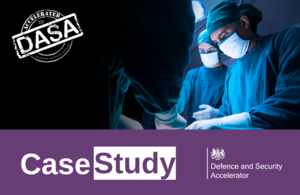Whole-body training model helps trauma teams sharpen their skills
DASA funding has helped Wales-based SME, Trauma Simulation develop a whole-body model for trauma training, from the point of wounding to damage control surgery

- DASA funding has helped Wales-based SME, Trauma Simulation, develop a modular and immersive, whole-body training model for trauma care
- The innovation has been adopted into the Military Operational Specialist Team Training course (MOSTT)
- The training model offers Combat Medics and Medical Emergency Response Teams (MERT) a highly realistic, low-cost and repeatable training solution
- With the help of DASA funding, Trauma Simulation is also developing a whole-body training model based on female anatomy and physiology
Simulated training plays a vital role in pre-hospital trauma care to help save more lives from combat-related injuries. However, current training solutions for trauma damage control, especially on unfamiliar junctional zones such as the groin and shoulder, often resort to using unrealistic single-use training manikins, and also, animal and cadaveric material. In addition, training models are typically limited to a default physiological male.
While these methods have a long established history and are useful for training, they can’t be used multiple times, are often costly, and may not be representative of realistic trauma injuries, both in appearance and limitations on the interventions which can be performed.
Introducing Trauma Simulation
Swansea University spin-out, Trauma Simulation recognised an opportunity to help enhance the trauma training experience with a solution that offers a full immersive experience for users that is more representative of trauma control procedures.
Funded by the Defence and Security Accelerator (DASA) Open Call in 2017, 2019 and 2023, the innovation is comprised of a life-like model, featuring a whole-body carrier-base, which includes the head and neck (including the airway), lungs, thorax, pelvis and upper thighs. In addition to the base, re-usable modules can be inserted into it to enable users to train for many different trauma procedures, such as:
- treating pelvic haemorrhage in patients with pelvic fractures
- junctional haemorrhage control
- inserting a windpipe
- fracture stabilisation
- incising through areas of burnt skin
The whole-body model and module inserts are specifically designed to provide a highly realistic simulation that fully immerses users. The model is crafted from silicone that replicates the texture of human skin, and even includes breathing and blood simulation for procedures that require it.

Trauma Simulation's whole-body training model in action
From idea to key component in a medical training course
Thanks to the modularity and re-useable nature of Trauma Simulation’s whole-body model, instructors now have the ability to efficiently retrain multiple operators throughout the entire chain of care. This is a significant advantage for MERT and pre-hospital teams, as it not only enhances the effectiveness of training, but also minimises the need to purchase single-use simulation models that can only simulate a limited number of medical procedures.
The DASA Open Call trialling process also revealed that the training model provides a great opportunity for users to authentically learn through trial and error in a practical setting. The carrier-base and module insert system ensures that users do not know which procedure to perform until they examine the model and realistically identify medical issues. This method creates a true-to-life simulation, making it impossible for users to simply glance at the training model and anticipate a particular intervention.
Trauma Simulation’s training models are now part of the Military Operational Specialist Teams Training (MOSTT) Course, a multidisciplinary course designed to bridge the gap between civilian practice and the deployed environment, as part of pre-deployment trauma training.
A Swansea University spin-out’s journey with DASA
Trauma Simulation, with only one employee at the time of receiving DASA funding in 2017, has made significant progress in developing their whole-body training model. Following their first round of funding, they acquired a second round of funding to develop modularity components and enhance the model’s authenticity.
More recently, in 2023, the SME obtained a third round of DASA funding to create a whole-body model centred on female physiology. Most training models of this nature focus solely on male physiology, however, there is a growing need for more realistic representation in the Armed Forces. By creating a female model, teams will be better prepared for female patients, while allowing greater relevance and flexibility in existing simulation exercises.
Trauma Simulation has also been highly successful, gaining valuable feedback from users who have participated in trials, such as during a deployment to Mali and aboard RFA Argus.
On working with DASA, founder of Trauma Simulation Professor Ian Pallister, said:
The support I have received through DASA has been game-changing. In close cooperation with Defence Medical Services colleagues, this support has enabled me to develop a system of advanced damage control surgical simulation models which are currently being used both in Military and Civilian education courses. The goal is to enable surgeons and their teams to train in time critical emergency procedures which can be life or limb-saving in all health-care settings. This would simply not have been possible without the support and engagement of the DASA Team. Thank you.
Further success for innovators in Wales
Innovators in Wales have reached a key milestone, receiving over £5 million in DASA funding for defence and security related projects.
DASA is thrilled to have strengthened and broadened our links to innovators based in Wales, drawing the best ideas for defence and security and helping them translate those ideas into action.
Learn more about DASA funded Welsh innovators here.
Get involved with DASA
DASA looks forward to working with more innovative Welsh companies. If you have a novel solution for a defence or security challenge, we want to hear from you. Reach out to your local DASA Innovation Partner today.